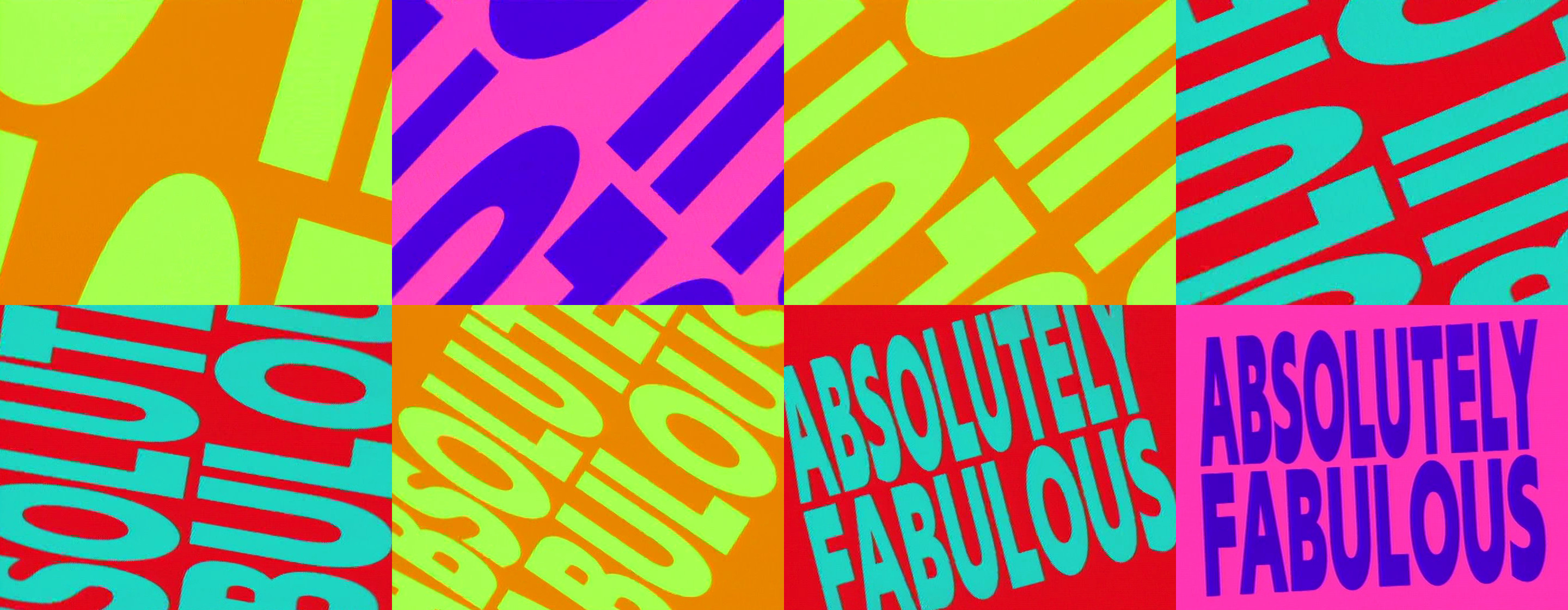
“The pilot show of a new sit-com about Edina, a neurotic, but successful woman who runs her own PR/design/fashion business and is obsessed with keeping up with the times. Her very sensible, teenage daughter Saffron lives with her and is forced into taking the mothering role. Edina is easily lead astray by her degenerate friend, Patsy, who is a magazine editor. Bubble is Edina’s secretary.
In this episode, Edina tries, unsuccessfully, to give up drinking.”
– Original internal billing for the pilot
It’s sometimes hard not to compare Bottom and Absolutely Fabulous. Both grew out of the same group of Comic Strip and Young Ones writer-performers. Both capture what those performers were doing at the turn of the new decade. Both are audience sitcoms on the, shall we say, larger side of the acting stakes.1
And most importantly for today’s discussion, both originated from a one-off pilot recording, with a full series recorded the following year. Hey, you know me by now. I can’t resist a good list.
| Absolutely Fabulous Series 1 | ||
|---|---|---|
| Episode | Studio RX | TX |
| Pilot/Fashion2 | 27-28/6/91 | 12/11/92 |
| Fat | 18-19/2/92 | 19/11/92 |
| France | 25-26/2/92 | 26/11/92 |
| Iso Tank | 3-4/3/92 | 3/12/92 |
| Magazine | 17-18/3/92 | 10/12/92 |
| Birthday | 10-11/3/92 | 17/12/92 |
The pilot of Absolutely Fabulous had location material shot on the 18th and 19th June 1991. There was then a pre-record day in Studio 4 at TV Centre just over a week later on the 27th June, followed by a recording in front of a live audience on the 28th June. There was then a gap of over seven months before the rest of the series entered production.3 The pilot finally transmitted on the 12th November 1992… 18 months after it was initially recorded.
I have access to some of the paperwork for that pilot episode here, and if you squint at it, we can made some guesses as to what happened to the pilot in that 18 month gap. For instance, the following line is in a different font to the rest of the page, and was clearly typed later:
OPENING TITLES SPECIALLY SHOT ON BETA & transferred to D3
Some material related to the music is also in a different font:
Musicians for sig tune – Costed to 1/LLV Q731H – Recorded 24 3 924
Opening/Closing Music by SIMON BRINT
Perhaps unsurprisingly, the following is also clearly typed later:
FINAL EDIT BY CHRIS WADSWORTH on Spool No D632800
Why am I telling you all this? Because from the above, we can tell that in between the pilot being recorded, and its final transmission, the team must have added new opening titles, added new title music, and then amended the paperwork to include both. The version of the programme which eventually transmitted on BBC2 in 1992 was LLC/C521/73; the paperwork would have been originally prepared for the previous edit, LLC/C521/72. An edit which was never broadcast.
Well, never intentionally broadcast, anyway.
Because when UK Gold started showing Absolutely Fabulous, somebody had clearly been a little careless with the version of the pilot they sent over to them. The result: for years, they accidentally showed the /72 edit of the pilot, put together long before the rest of the series was finished. And while Gold finally corrected the error around 2017, I’ve recently got hold of what the channel repeatedly aired all those years ago.
Which means we can now take a little look at the pilot of Absolutely Fabulous in its 1991 incarnation, rather than its final 1992 broadcast.
* * *
All times given are from the 1992 broadcast/DVD/iPlayer version of the show, so you can tell exactly where the changes have been made.
(00:00) The 1992 broadcast version includes the beautiful opening titles you can see at the start of this article.5 The 1991 pilot edit has no opening titles at all, but simply starts with the scene featuring Edina in her bedroom.
However…
(00:24) … the 1991 edit still has to tell us what the show’s called, so it superimposes a slightly rough-and-ready logo over that opening scene:

1991 Pilot Edit
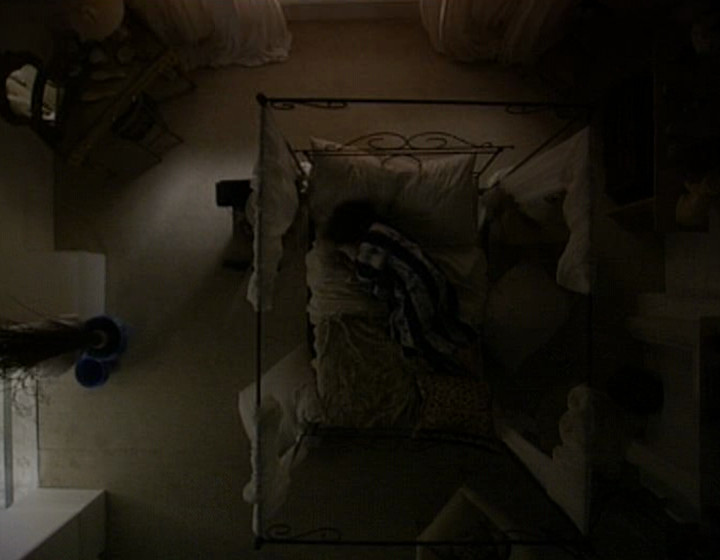
1992 Broadcast Edit
Interestingly enough, the ABSOLUTELY there is in Bodoni Condensed, or a close variant. Which is a font never used in Series 1 of Ab Fab… but Bodoni is used for the new opening titles for Series 2!
(13:46) In the car on the way to the office6, the 1991 edit has some additional dialogue which was cut for the final 1992 version. After Edina gets off the phone to Bubble – “Just do your best darling. I’m rushing, bye” – there was originally more discussion about Edina’s drinking:
EDINA: From now on, I’m only going to drink when I’m thirsty.
PATSY: Can you do that on your own?
EDINA: I’ve thought of doing colour healing, because you know that helped with my energy crisis in my vegan period.
PATSY: What did they do?
EDINA: Held up a purple card and told me to eat meat. Or I could have an earring put in. You know, and just turn it every time I crave alcohol. Not that I crave it.
PATSY: No, of course you don’t.
EDINA: It’s just I don’t have the desire not to drink at the moment, you know. But if I can just prove to her that I can stop, then she will know I am not an alcoholic and I can just go on drinking.A shot of outside the car.
EDINA: (VO) Anyway, if I…
PATSY: (VO) Oh darling, do stop…Back inside the car.
PATSY: Don’t get an earring, that’s all, it’s all guesswork. I had one put in when I wanted to lose weight, but every time I turned it, I just pissed my pants.
EDINA: I shouldn’t have left them so much to do in the office.
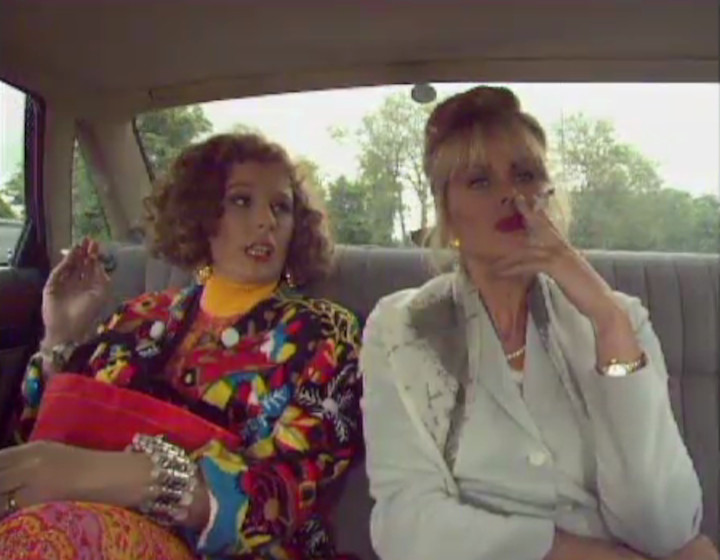

The 1992 edit then picks up here, with Patsy asking “Are you going straight to the office?”
The above is the only difference between the two versions where an actual edit has been made to the dialogue. Whether it was deleted from the final version for reasons of pace, or simply to make room for the new opening titles, it’s impossible to say. Regardless, it’s very sad to lose Joanna Lumley say the phrase “I just pissed my pants”.
(27:47) The rest of the episode is identical in both versions, until we get to the end credits. In the 1991 edit, the credits start here, just after Edina appears at the window and says “Sweetie, darling…” In the final 1992 edit, they start 13 seconds later, after Edina bellows “SWEETIE DARLING LET ME IN!”
The end credits themselves are in a completely different design between the two versions:
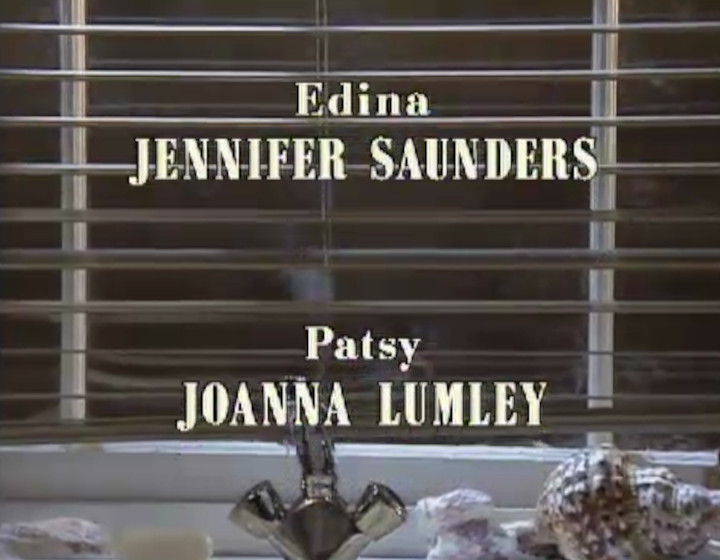
1991 Pilot Edit
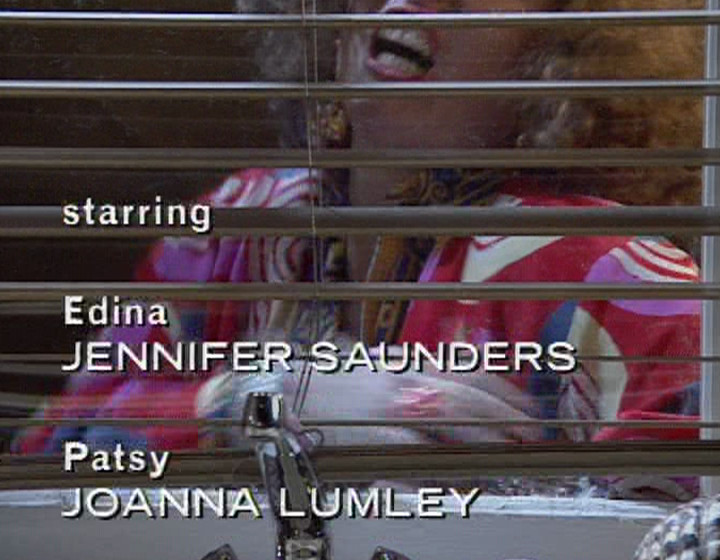
1992 Broadcast Edit
Again, with the use of Bodoni, the pilot actually looks far more like Series 2’s end credits than Series 1:

1991 Pilot Edit
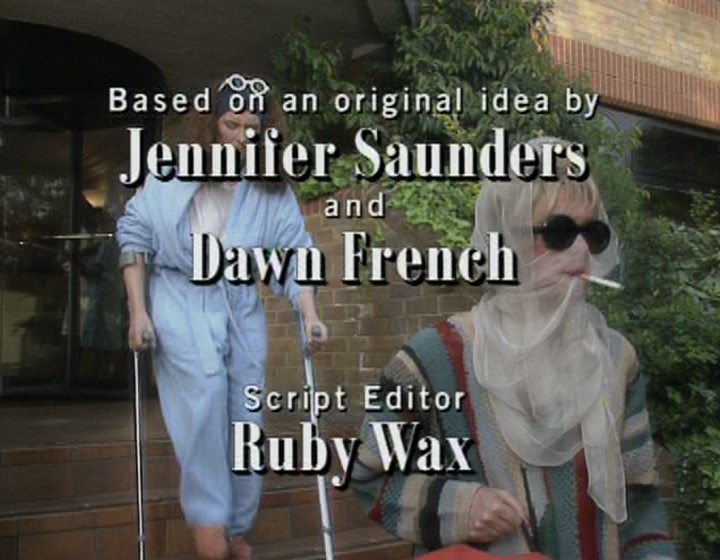
Series 2, “Hospital”
As for the actual credit text itself, that also has numerous tweaks. As well as the order of certain credits being changed:
- Nickolas Grace as Jonny is credited as a guest star in the 1991 edit, but not in the 1992 edit. June Whitfield gets guest star billing in both versions.
- The 1991 edit has the credit “Based on an original idea by Dawn French & Jennifer Saunders“. The 1992 edit swaps round the two names.
- For me, the most interesting change of the lot: Ruby Wax gets an Additional Material credit in the 1991 edit, but is credited as Script Editor in 1992.7
- Obviously, the 1991 edit has no music credit at all, as there was no original music. The 1992 edit credits Simon Brint for the music, and Julie Driscoll & Adrian Edmondson for the vocals.
- Liz England gets a Casting Adviser credit in the 1992 edit, but not in the original 1991.
- Kevin Rowley is credited as Film Cameraman in the 1991 edit, but for Location Camera in the 1992 version. This makes more sense; all the location sequences in Series 1 are VT, not film.
- Andrew Smee gets a Graphic Design credit on both versions, but Bernard Heyes is only credited on the 1992 version. Bernard was responsible for the new title sequence.
- The 1991 edit includes Producer Jon Plowman and Director Bob Spiers in this main set of credits in Edina’s bedroom; the 1992 edit leaves them until the very end of the programme.
- The 1991 edit has a 1991 copyright date. The 1992 edit has a 1992 copyright date. And before you make fun of me for mentioning this, I’ve known transmitted programmes which have somehow managed to get the date wrong.
(28:00) At this point, the 1992 edit plays the new title music, “This Wheel’s on Fire”. The 1991 edit has no music during the end credits whatsoever.
Of all the changes made to the 1992 edit, I think adding the music has by far the most impact; far more than the missing dialogue in the car scene. It’s easy to underestimate just how brilliantly that music sets the tone and mood of the show. It does an awful lot of the heavy lifting.
However it does mean that the dialogue during Edina’s bedroom antics at the end is far more clearly heard in the 1991 edit. “Where’s my joint box?”
(28:25) An interesting change here: the 1991 edit mixes through to the kitchen with Saffy on the phone a second earlier than the 1992 edit, although the soundtrack is identical. The result is a much smoother scene transition, with less of Julia Sawalha hanging around before her line.
(29:13) One of the very best things about the first series of Ab Fab are the endings, brilliantly punctuated with a burst of theme tune and freeze-frame.8 Of course, the 1991 pilot edit is missing the final burst of theme… and, indeed, the freeze. The result: the punchy ending is less punchy, and less amusing.
* * *
And that’s your lot. You might be a little disappointed that the original edit of the pilot didn’t have more changes compared to the final version. And yeah, maybe it is. It certainly would have been interesting to find some scenes had been entirely re-recorded before broadcast.
On the other hand, I find it immensely satisfying that the show managed to get so much right, so early, that not only did they not have to re-record anything, but it was barely even touched at all. Throw new opening and closing credits on, shorten one scene, and they were done. It really was a show which came out fully formed.
Well… nearly, anyway. More next time.
With thanks to Mark Aldridge for telling me about the original UK Gold broadcasts of the pilot, Tanya Jones for her usual editorial advice, and Milly Storrington for archive research.
Both were also made under the variety department rather than comedy, allowing them two days in the studio rather than one, making them feel rather more lavish than many other sitcoms. And all this without a band in sight. ↩
The paperwork I have access to only calls the episode “Pilot”. The name “Fashion” for this episode first seems to have been used on the 1993 UK VHS release. ↩
The next thing to be recorded for the programme was location material on the 5th February 1992. ↩
I bet you’d like to know who played on the original Ab Fab version of “This Wheel’s On Fire”, wouldn’t you? Here you go: Dave Stewart (keyboards), Steve Pearce (bass guitar), Steve Sanger (drums), Roddy Matthews (guitar), and Simon Brint (keyboards). ↩
By far my favourite Ab Fab opening, by the way. I wish they’d kept it for at least a couple more series. ↩
Well, via Harvey Nicks. ↩
Jennifer Saunders goes into exactly what Ruby Wax’s role in Absolutely Fabulous was in her book Bonkers: My Life in Laughs (Viking, 2013):
“I have to point out, here and now, that I was not alone in the writing of Ab Fab. Ruby Wax played a huge part. In fact I credit Ruby with some of the show’s funniest-ever lines. We needed a script editor, and I chose Rubes because no one can turn the world on its head like she can.
I would write the scripts in fear of having to show them eventually to Ruby. She was so brilliant, and I was afraid that they would be substandard. I didn’t give Ruby long with any of the scripts, but it was always worthwhile. She would take them, read them, and then we would meet. I would see that the scripts were covered in her scribble. She would go through them, scene by scene, giving alternative lines and possibilities, and at some points just saying, ‘I don’t understand the next two pages but I guess you know what you’re doing.’ She gave me all her thoughts and I could take ’em or leave ’em.”
Once you read that, you can understand why Additional Material seems just as fitting a credit in many respects as Script Editor. ↩
My favourite is probably in the second episode. “Thin? Ha!” ↩

6 comments
John J. Hoare on 5 June 2025 @ 9am
For those of you who know the next part of the story, from the Series 1 script book and Absolutely Not – no point discussing that here, it’s all coming in Part 2 next week. Just so we can keep the comments tidy!
Adam Tandy on 5 June 2025 @ 10am
Great article John. It pre-dates my involvement with the show, but footnote 1 is getting to the end of its useful time as an indicator of budget levels. John Birt brought in Producer Choice around about then, which meant that budgets were becoming more transparent, and the bottom line was now much more of a real indicator of cost. I think Variety “sitcoms” were probably still treated more generously (both AbFab and Bottom were always expensive shows) at this time, but by 1991/2 budgets were being interrogated much more rigorously. Also, Comedy and Variety were then merged in 1993 to become Entertainment, with a new Prog No Core Prefix. For a while, Entertainment just used up old LLC and LLV numbers until the new number cores could be issued. I looked after both types.
The /73 edit is made onto a D spool. This is a very, very early D3 edit, which must have pleased Chris Wadsworth as it meant the whole series was in one digital format, rather than having the pilot live on an old analogue tape.
James on 5 June 2025 @ 10am
The fact that the pilot version is a 72 edit means there must have been an earlier 71 edit as well- would be interesting to know what’s different between that and this version, if it even still exists.
John J. Hoare on 5 June 2025 @ 11am
Adam: Many thanks for your very useful input as ever. I have to admit, the significance of the final spool number had entirely passed me by! (Although I was wondering, if you were doing a remastering of the episode, whether you could drop to the /72 for most of it and gain a generation? Maybe not worth it if the final edit was done on D3?)
James: Yes, I’ve found no reference to what was in the /71 edit. I highly suspect if it still exists anywhere, it’s a VHS dub in the hands of Wadsworth/Plowman/Saunders/etc! My guess would be that it contained at least one of the cut scenes I’m going to detail in the next article, but I have no proof.
James on 5 June 2025 @ 2pm
When it comes to early edits popping up, I think of Sickness and Wealth on the Series 6 DVD of OFAH. The main difference is that it’s the best part of 10 minutes longer with several extended scenes, including an appearance by Mickey and Jeavon who don’t appear in the broadcast version (though Patrick Murray and Steven Woodcock are still credited in it). It really stands out because the Nag’s Head scenes have no music or crowd noise dubbed on so they seem eerily quiet (similarly, we’ve had a couple of EastEnders episodes on Drama where music hasn’t been dubbed on, so we have people dancing to and shouting over nothing).
Though whether that OFAH inclusion was intentional or just another case of “grabbing the first tape off the shelf”, I don’t know. I guess at least it meant we get extra footage, unlike the countless case of where US shows where cut down syndicated edits have been grabbed for DVDs and streaming.
Rob Keeley on 5 June 2025 @ 4pm
John, I never knew anyone like you for getting me excited over unbroadcast pilot edits.
I’m still waiting for You Rang M’Lord part two, by the way! Nearly four years now. ;) Though there have been some great articles in the meantime.